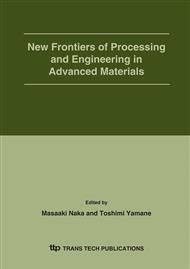p.281
p.287
p.291
p.297
p.303
p.309
p.315
p.321
p.327
Material Processing Using Supersonic Reactive Plasma Jets in Thermodynamical and Chemical Nonequilibrium State
Abstract:
Nitriding of metals and reactive spraying for nitride ceramics are planned using a 10-kW-class direct-current nitrogen or H2/N2-mixture arc plasma jet generator with a supersonic expansion nozzle in a low pressure environment. The H-atom electronic excitation temperature and the N2 molecule-rotational excitation temperature intensively decreased downstream in the nozzle although the NH molecule-rotational excitation temperature did not show an axial decrease. As approaching the titanium plate for nitriding, the thermodynamical nonequilibrium plasma came to be a temperature-equilibrium one. Both the electron number density near the plate and the heat flux into the plate increased with H2 mole fraction for mixtures gases. In cases with H2/N2-mixtures, a radical of NH with a radially wide distribution is considered to contribute to the better nitriding as a chemically active and non heating process. Numerical simulation was carried out to examine interactions between injected ceramic particles and the nitrogen plasma flow. When plasma was accelerated to supersonic flow through the nozzle, ceramic particles were smoothly accelerated by the aerodynamic drag force and heated in the highly-reactive plasma flow. The calculated results showed that the supersonic plasma jet in thermodynamical and chemical nonequilibrium state might have some potentials for material processing, even for spraying, because of its high reactivity.
Info:
Periodical:
Pages:
303-308
Citation:
Online since:
December 2005
Authors:
Price:
Сopyright:
© 2005 Trans Tech Publications Ltd. All Rights Reserved
Share:
Citation:


